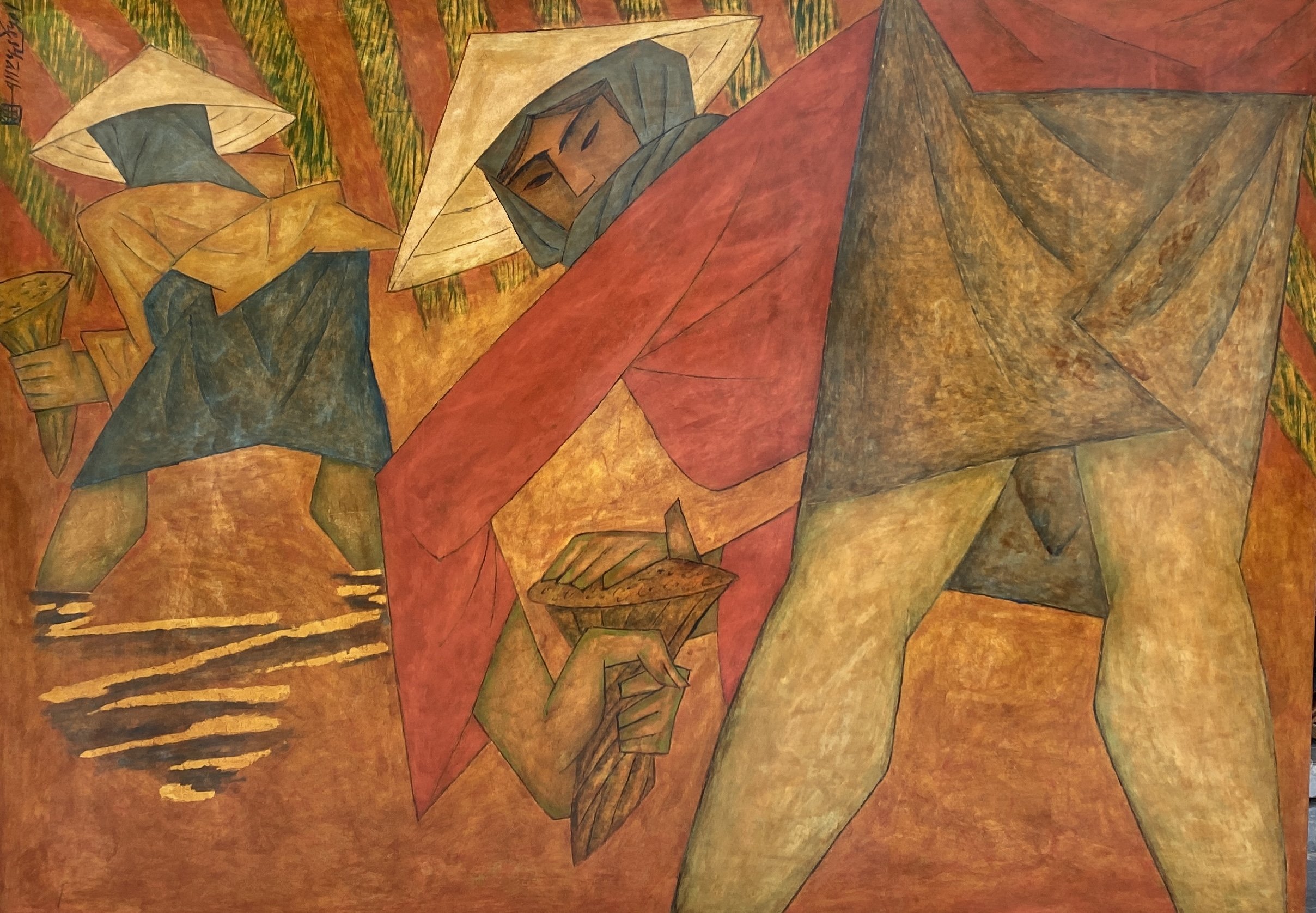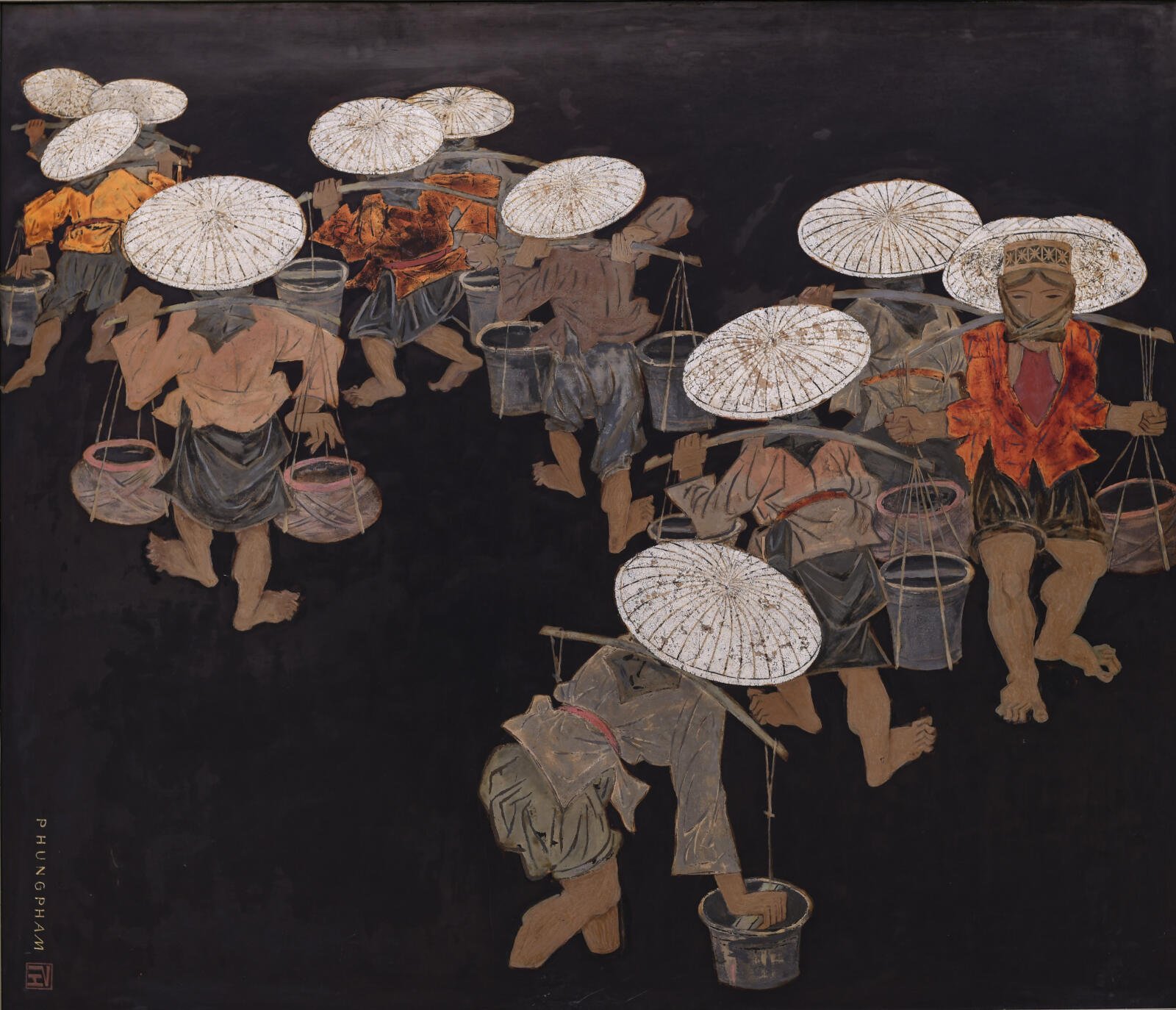
"Two reapers" 2006 (Lacquer on wood, 120 x 160 cm)

"Casting nets" 2008 (Lacquer on wood, 120 x 160 cm)

"Transplanting rice" 2009 (Lacquer on wood, 118 x 166 cm)
Art never stops - Lacquer paintings and the echoes of Shapes
It may be said that the interplay of lines along with flat, black and white spaces ceased to satisfy the aesthetic and sense of imagination of the artist. Phung Pham often tried to create shapes and depth using only black and white. However, the limited size of the woodblock print came to represent a barrier for him, he who constantly seeks a tributary into the vast sea, to work on a grand scale, and to revel in the expansive space of creative freedom.
The dream of transitioning to lacquer paintings began to take shape in the late 1980s, after the Doi Moi. One of the experiments, a painting entitled, “Fighting against drought” (1990, lacquer on wood, 113 x 133 cm), brought success to the artist, including a gold medal at the Nationwide Fine Arts Exhibition in 1990.
(continued below)

"Proud I" 2007 (Lacquer on wood, 90 x 55 cm)

“Fighting against drought”, 1990 (lacquer on wood, 113 x 133 cm), Gold Medal in Vietnam Nationwide Exhibitions 1990, Collection of Vietnam Fine Arts Museum

"Beside lilies" 2008 (Coromandel lacquer, 120 x 80 cm)
Initially, some existing wood engravings were used as a base for the lacquer paintings. They were enlarged in size, with sparkling colors and a certain mystical quality of lacquer material. Especially notable is the color palette of brownish yellow, bronze yellow, and the reddish brown of the earth, or else slate, green and purple, reminiscent of mountains, and forests. All of these affect a profound sense of resonance, ancient echoes, and the heritage of countless generations. This was a highly experimental period for the artist, as he immersed himself in the free play of unfettered creativity.
In the lacquer paintings, the existing themes and images in his repertoire are transformed into three-dimensional masses, blocks, cylinders, cones and pyramids. They are more solid, taut, with sharper angles, often depicted in an enlarged, close-up, frontal perspective. Thus, human figures appear rough and monumental, resembling bas-reliefs or sculptures. Although flat space is still present, the raised forms emerge through a technique of obfuscation and the blending of light and shade, as is commonly seen in painting. Some of these artworks impart the sensation of three-dimensional bronze statues, bold and powerful, as if there is a voice echoing from within in a modern language. Phung Pham’s lacquer paintings are not glossy and smooth like traditional lacquer paintings. He has his own technique, applying layers of color and polishing in order to produce a precisely desired effect. This blending of colors and the interweaving of layers conspire to create a sparkling harmony on the surface, owning to the shining layers of gold or silver beneath. The artist has expressed his opinion that the glossy finish is not suitable for the raw and robust language of this style. The artistic glamour and luxurious golden shine of lacquer materials are not necessarily appropriate or desirable in every instance.
In his 90s, Phung Pham continued to labor in artistic pursuits, where drawing is tantamount to his very breath, and the joy of his life. His art, from woodblock prints to lacquer paintings, possesses a unique resonance and vitality, as well as a certain strangeness. It spans from East to West, from traditional Vietnamese to the language of the modern world. The stories, themes, and people are drawn either from Vietnamese cultural history, or the universal stories of humanity throughout time. As these themes are conveyed by the artist and depicted on canvas, they are honored in the enduring and timeless beauty of art. Perhaps, that is the most noble significance of an artist’s life.
Bui Nhu Huong
Art Researcher and Critic
written in March 2023

"The parting" 2009 (Lacquer on wood, 120 x 74 cm)

"Harvesting time" 2009 (Lacquer on wood, 160 x 120 cm)

"Threshing wheat I" 2011 (Lacquer on wood, 143 x 90 cm)

"Harvesting" 2023 (Lacquer on wood, 160 x 120 cm)

"Sunday" 2001 (Lacquer on wood, 120 x 160 cm). This artwork previously was on display at Phung Pham’s solo exhibition “ At the Height of Summer” at Jee Stone Gallery, Hong Kong in 2006. After its journey, this artwork returned to its motherland in VIetnam and later became an important piece within Thang Long Gallery’s collection.

“The stepchild” 2005 (lacquer, 4 panels, 140 x 240cm) depicts a mother bathing her mixed-race child - a child born of war - in an enlarged, grown-up form. The scene portrays that above all is the sacred and unparalleled love of the mother.
Artist Phung Pham
“Among the paintings I create, women make up the majority. Everyday activities comprise my themes, such as combing hair, looking in the mirror, or sitting and waiting for a lover. Love between men and women has existed for thousands of generations. Love between men and women exists everywhere. The ability to love and care for one another is a sign of human culture. I enjoy depicting this theme in lacquer paintings or woodblock prints. However, in Vietnam, there are still restrictions, especially when it comes to depicting love in nude.”

"Enjoying the cool breeze" 2015 (Lacquer on wood, 160 x 120 cm)

"Longing I" 2010 (Lacquer on wood, 122 x 73 cm)

"Kiss III" 2019 (Lacquer on wood, 114 x 69 cm)

"In front of the mirror" 2011 (Lacquer on wood, 160 x 120 cm)

